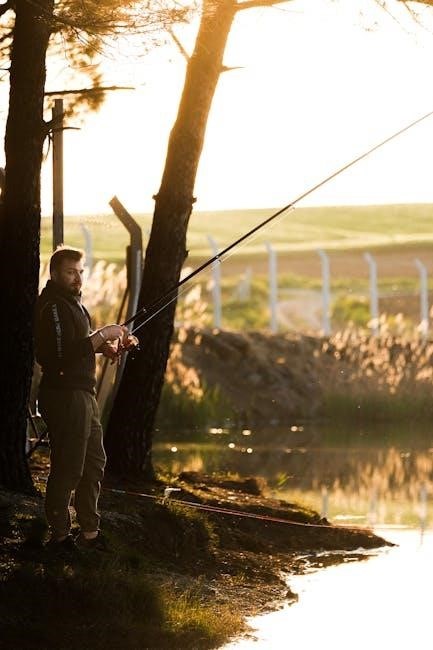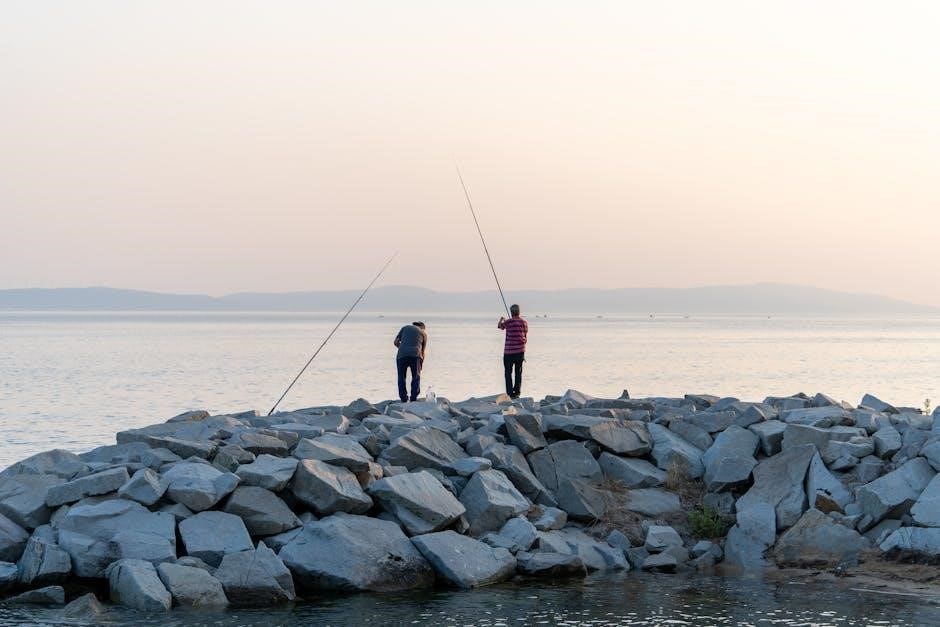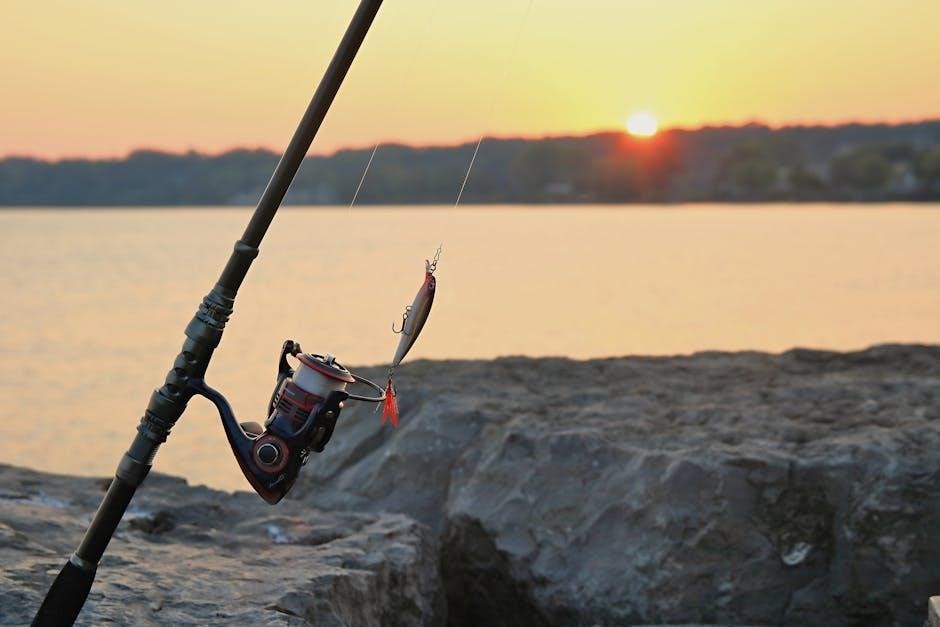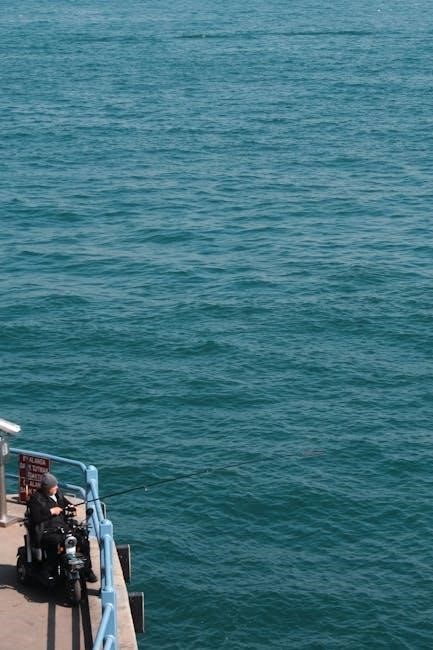Choosing the right fishing pole size is crucial for an optimal fishing experience. Rod length and action play a significant role in performance, sensitivity, and overall success. This guide helps anglers select the perfect rod by balancing species, technique, and personal preferences for a tailored fishing setup.
Key Considerations for Choosing the Right Fishing Rod
When selecting a fishing rod, several factors come into play to ensure the best fishing experience. The type of fish you’re targeting is a primary consideration, as different species require specific rod lengths and actions. Your height and casting style also influence the ideal rod length, with taller anglers often benefiting from longer rods. Additionally, the fishing environment—whether it’s freshwater, saltwater, or surf—plays a role in determining the appropriate rod size. Line weight and lure size recommendations, often specified on the rod, should align with your fishing goals. Finally, personal preference regarding rod action (fast, medium, or slow) impacts sensitivity and hook-setting power. Balancing these elements ensures a rod that suits both your needs and fishing style.

How Fish Species, Rod Length, and Action Impact Your Fishing Experience
The species of fish you’re targeting greatly influences the ideal rod length and action. Larger, fighting fish like tuna or marlin require longer rods (7-9 feet) for leverage and strength, while smaller species like trout or panfish can be effectively caught with shorter rods (5-6 feet). Rod action also plays a critical role: fast-action rods provide superior sensitivity and quick hook-setting power, making them ideal for lure fishing, while medium or slow-action rods offer more flexibility, often preferred for bait fishing or handling larger, harder-fighting fish. Matching the rod’s specifications to the fish’s size and behavior ensures better control and a more enjoyable fishing experience.
The Role of Personal Height and Fishing Technique in Rod Selection
Personal height and fishing technique significantly impact rod selection. Taller anglers may prefer slightly longer rods for improved casting leverage, while shorter individuals might find shorter rods more manageable. Casting style also plays a role; overhead casting often benefits from longer rods, whereas spin or fly casting may favor shorter lengths. Additionally, fishing in tight spaces or open water influences rod length choices. Technique-specific needs, such as sensitivity for light tackle or strength for heavy-duty fishing, further guide selection. Matching rod length to your height and technique ensures comfort, reduces fatigue, and enhances overall fishing performance. This personalized approach helps anglers optimize their gear for specific fishing scenarios and preferences.
Understanding Fishing Rod Length and Its Importance
Fishing rod length impacts casting distance, leverage, and control. Longer rods enhance distance and leverage, while shorter rods improve accuracy and maneuverability in tight spaces.
How to Determine the Ideal Rod Length for Your Fishing Needs
To determine the ideal rod length, consider the type of fishing, target species, and environment. For ultralight fishing, shorter rods (5-6 feet) offer precision and control. Medium-length rods (6-7 feet) are versatile for most freshwater and light saltwater applications. Longer rods (7-9 feet) excel in surf fishing and casting long distances. Personal height and casting style also matter; taller anglers may prefer longer rods for better leverage. Match rod length to the fish size and terrain—shorter rods for tight spaces, longer for open waters. Testing different lengths can help identify the most comfortable and effective fit for your fishing style and goals.
Pros and Cons of Different Rod Lengths for Various Fishing Styles
Short rods (5-6 feet) are ideal for ultralight fishing, offering precise control and maneuverability in tight spaces. However, they lack casting distance and leverage for larger fish. Medium rods (6-7 feet) strike a balance, suitable for most fishing styles, but may not excel in extreme conditions. Long rods (7-9 feet) are perfect for surf fishing and casting far, but can be cumbersome in close quarters. Each length has trade-offs: shorter rods sacrifice distance for accuracy, while longer rods offer reach but require more strength. Understanding these pros and cons helps anglers choose a rod that aligns with their specific fishing style and environment, ensuring a more enjoyable and productive experience on the water.
Matching Rod Length to Fish Size and Fishing Environment
Choosing the right rod length is crucial for effectively targeting specific fish sizes and adapting to various fishing environments. For smaller fish like trout or panfish, shorter rods (5-6 feet) provide precise control and are ideal for tight spaces. In contrast, larger game fish such as salmon or tuna require longer rods (7-9 feet) to handle their strength and the often greater casting distances. The environment also plays a significant role; shorter rods excel in confined areas like rivers or ponds, while longer rods are better suited for open waters or surf fishing. Balancing rod length with fish size and habitat ensures optimal performance and enhances the overall fishing experience. This tailored approach helps anglers maximize their success and enjoyment on the water.

Exploring Fishing Rod Action and Its Impact on Performance
Fishing rod action determines flexibility and sensitivity, affecting hook-setting power and technique. Fast action rods offer quick responsiveness, while medium and slow actions provide varying degrees of flex for different fishing styles.

Fast, Medium, and Slow Action Rods: What’s the Difference?
Fishing rod action refers to the flex and responsiveness of the rod. Fast action rods are stiff, offering quick sensitivity and powerful hook-setting capabilities, ideal for lure fishing. Medium action rods provide a balance between flex and strength, suitable for general fishing techniques. Slow action rods bend more, offering more forgiveness and control, often used for lighter tackle and smaller fish. Each action type caters to specific fishing styles, with fast action preferred for precision and medium to slow actions for versatility. Understanding these differences helps anglers choose the right rod for their target species and fishing method, enhancing overall performance and enjoyment on the water.
Choosing the Right Action for Lure Fishing and Bait Fishing

Choosing the right rod action is essential for both lure and bait fishing. Fast action rods are ideal for lure fishing as they provide quick sensitivity and powerful hook-setting capabilities, crucial for detecting bites and reacting swiftly. Medium or slow action rods are better suited for bait fishing, offering more flexibility and forgiveness, which helps in handling larger fish without the risk of the hook tearing out. Fast action rods excel in precision and control, making them perfect for active fishing techniques, while medium or slow action rods accommodate a more relaxed approach, allowing anglers to wait for bites without missing hook-sets. Understanding these distinctions ensures anglers can optimize their fishing experience based on their preferred method.
How Rod Action Affects Sensitivity and Hook-Setting Power
Rod action significantly influences sensitivity and hook-setting power. Fast action rods provide heightened sensitivity, allowing anglers to detect even subtle bites quickly. Their stiff design enables rapid hook-sets, essential for techniques requiring immediate response. Medium action rods offer a balance, combining moderate sensitivity with forgiving flexibility, which helps in managing larger fish without losing hook contact. Slow action rods prioritize flexibility over sensitivity, reducing the risk of hook tears but making hook-sets less immediate. The choice of action depends on the fishing style and target species, ensuring optimal performance in sensitivity and hook-setting effectiveness.

Final Tips for Selecting the Perfect Fishing Rod
Match your rod to the target fish, consider your height and casting style, and select action based on your fishing goals for optimal performance.
How to Match Your Rod to the Fish You’re Targeting
Matching your fishing rod to the species you’re targeting is essential for success. Larger fish like bass or pike require sturdier rods with more power, while smaller species like trout or panfish thrive with lighter, more sensitive setups. Consider the fish’s fighting ability and size to choose the right rod strength. For example, a medium-light action rod is ideal for smaller fish, offering better sensitivity, while a heavy action rod is best for larger, stronger fish. Always check the rod’s specifications, such as line weight and lure capacity, to ensure it aligns with your target species. This balance ensures optimal performance and a more enjoyable fishing experience.
Considering Your Height and Casting Style
Your height and casting style are critical factors in selecting the right fishing rod. Taller anglers often benefit from longer rods, which provide better leverage and control during overhead casts. Conversely, shorter anglers may find shorter rods more comfortable and manageable. Casting style also plays a role; for example, a flip or roll cast may work better with a shorter rod, while longer rods excel in open-water settings. Handle length should also align with your height for optimal comfort. By considering these personal factors, you can choose a rod that enhances your casting efficiency and overall fishing experience, ensuring a more enjoyable and productive time on the water.

Selecting the Right Action for Your Fishing Goals
Selecting the right rod action is essential for achieving your fishing goals. Fast action rods offer superior sensitivity and quick hook-setting power, making them ideal for lure fishing and situations requiring precise control. Medium action rods provide a balance between strength and flexibility, making them versatile for various fishing styles and species. Slow action rods are better suited for smaller fish and finesse techniques, allowing for more natural lure presentation. Understanding the action ensures you can match it to your fishing technique, target species, and preferred lures. By choosing the right action, you enhance your ability to detect bites, set hooks effectively, and enjoy a more successful fishing experience tailored to your specific needs and preferences.





